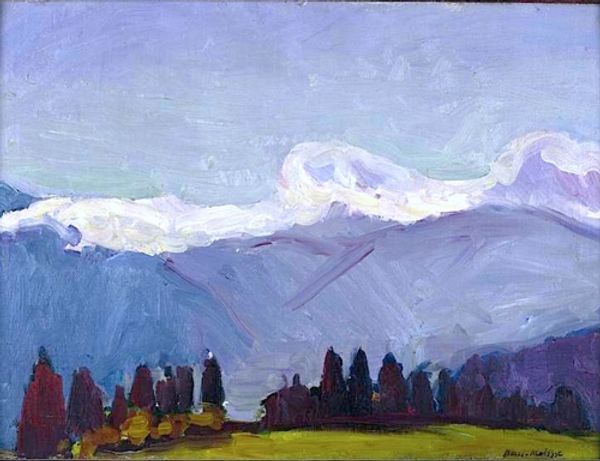
Dimensions: 68.6 x 111.8 cm
Copyright: Public domain
Curator: We’re looking at “Clearing,” an oil painting completed in 1942 by the Canadian artist Emily Carr. Editor: It strikes me as intensely spiritual, almost melancholic. The skeletal trees against that turbulent sky...it feels like a place where the veil between worlds is thin. Curator: Carr was deeply invested in capturing the essence of the British Columbia landscape and its spiritual dimensions. During her lifetime, this natural environment was being threatened with logging practices, contributing to a sense of devastation, clearly visible throughout. Editor: The dead trunks, jutting skyward… they remind me of figures reaching out in supplication or even desperation. The entire landscape becomes imbued with this sense of suppressed sorrow. Even with the hopeful yellows on some of the remaining foliage, they offer such sharp contrast with all the green surrounding them. Curator: It's compelling how Carr, despite the colonial implications of her project, strove to represent the land through her own lived experience, attempting to move away from a purely settler-colonial vision and towards an integration of Indigenous spiritual perspectives that understood it as a conscious presence. She was interested in revealing a dimension deeper than the material reality of it, one could even say a spirit of place. Editor: The swirling brushstrokes definitely contribute to this animated feel. Those thick lines practically vibrate, giving a very active and tangible quality to this silent place, yet that silence gives the viewers room to reflect. I feel compelled to see more. What cultural artifacts are layered and lost? Is it inviting or a warning? Curator: Well, looking back, the paintings created throughout Carr’s artistic path were seen to be, through subject matter and in a social context, radical for their time. Her works faced negative critiques or remained largely ignored at the time because they expressed, as many interpreted, unconventional and even uncomfortable expressions in light of socio-economic progress during that time period. Editor: That just shows how art, when powerful, always makes some uneasy. Now, after really immersing myself with "Clearing" I'm starting to believe this painting might hold more messages of rebirth instead of only a lamenting call of sadness. The painting doesn't give any concrete answers, however it manages to offer room to ponder the mysteries that emerge when things have settled in both material landscapes, as well as within human interior spaces. Curator: I agree. Despite Carr’s personal struggles with recognition, she persevered, making lasting contributions not only to the Expressionistic Canadian art scene but as a figure and role model for women entering what had traditionally been a very masculine-dominated territory, she's someone to remember when we consider the institutions around art making, the ones that still frame it today.
Comments
No comments
Be the first to comment and join the conversation on the ultimate creative platform.













